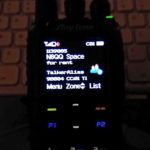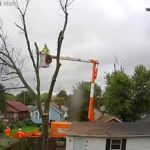
When I bought my first Tytera MD-380 in 2016, I wondered why there weren’t any call signs popping up on the radio display. Just cryptic ID numbers. Surely I’d missed a setting somewhere. From my experience with D-STAR, it never occurred to me that call signs might not be embedded into a digital voice mode. And so I learned how DMR, a mode designed for the commercial world, was adapted for amateur radio — a mode without alphanumeric identification or routing.
You might already know that this was solved by CCS7 (Callsign Communication System), a scheme that marries 7-digit numbers with amateur radio call signs, and an offshoot of the older D-STAR CCS. The official user databases of CCS7 IDs and corresponding user information is typically downloaded from the Internet and uploaded to the radio’s memory so that it can display the transmitting station’s call sign, name, and location on the radio’s screen. You might think that something more dynamic like the Internet’s DNS system would apply here, but it needs to work in the field where hams are using repeaters and simplex, and aren’t connected to the Internet.
Early on, I noticed something called “Talker Alias” in the settings of the MD-380’s custom firmware, but I had no clue what it meant. Nobody ever mentioned it in tutorials or on the air. It was only when I tried cross moding between a DMR radio and a System Fusion reflector using the SharkRF openSPOT that it became apparent. Talker Alias is an addition to the DMR specification that adds a user-configurable alphanumeric string to the data stream. Firmware and server entities like Brandmeister, SharkRF, and Pi-Star were quickly on board and started injecting a Talker Alias string into the data stream for you if one wasn’t already there. Getting radios and repeaters to support it has been another matter. Motorola is decidedly not on board.
Talker Alias’ obvious purpose is to remove the need for radios to store a user database that must then be continually updated, something D-STAR and Fusion have never had to worry about. But for my DMR / Fusion cross mode testing, Talker Alias came into play for passing Fusion’s call sign string through to the DMR radio’s display. openSPOT uses Talker Alias to do it. The two main versions of the MD-380 custom firmware support Talker Alias, so I should have been able to use it. But…
While monitoring the Fusion reflector FCS00390, linked to the popular WIRES-X America Link room, I noticed that the MD-380 would show the correct call sign the first time it received a transmission. But then it would keep showing that same call sign every transmission after. It fact, it would stick on that same call sign until you rebooted the radio, regardless of who was actually transmitting. At that point I wasn’t sure what was causing it. Thinking that the problem was the openSPOT, I went to the SharkRF forums where Norbert HA2NON confirmed that everything was okay with their firmware. He was using a Hytera rig with working Talker Alias that showed everything to be working correctly. He suggested I confirm this by using their USB logging facility to watch the packets pass through from the hotspot to the radio — and he was right. Good man, that Norbert. Very helpful and quick to respond.
Now that I knew what to expect from Talker Alias, I could see the same bug happening through all my hotspots with DMR which exposed the MD-380 firmware as the problem. I described the sticking-call-sign bug in great detail on one of the firmware related Facebook groups and nobody answered. I told people about it on the air, and nobody knew what to make of it. I don’t think most other hams really knew what Talker Alias was at that time. After all, the popular call sign database scheme was good enough for everyday use and masked the need for Talker Alias — none of us really had to think about it. I hadn’t known either until trying this DMR / Fusion cross mode application, one of the few things where it’s almost a necessity.
Without a reliably working Talker Alias to test against, I was hesitant to officially report the MD-380 bug to the firmware developers. The last time I checked, both versions of the custom firmware still had the problem. Yet I still feel like maybe there’s something I’m missing. How could that kind of bug still be there after all this time otherwise?
I swore that I’d never buy another DMR rig unless it had Talker Alias. It took a couple years, but now that I have an Anytone AT-D878UV (which I will henceforth refer to as “the 878”), I finally see Talker Alias working like it’s supposed to, and experimentation can continue.
While doing the same DMR / Fusion cross mode testing with a Pi-Star hotspot (DMR2YSF mode), I found that it transports the Fusion data string to the DMR radio display in a rather different way. It doesn’t use Talker Alias. Watching the display, it appears to parse the call sign out of the Fusion data string, do a reverse lookup in the DMR user database, and simply send the CCS7 ID to the radio where it shows you the user database info just like it would for DMR. And if the call sign isn’t registered in the database, it sends your own ID so that the transmission looks like it’s from you. Kinda weird.
On a radio with Talker Alias, I prefer the faithful pass-through of the Fusion string on the openSPOT. On a radio that doesn’t have Talker Alias (or does have buggy Talker Alias), the Pi-Star reverse CCS ID lookup is the better option. As always, the ability to set your preference would be ideal.
Talker Alias has been fun to watch on the 878. Seems like a rather mundane thing to spend time on but I have the radio configured to show the user database info for a few seconds, then it switches to Talker Alias. People are discovering that you can set your own string in Brandmeister’s self care settings — I’ve seen a few along the way that made me chuckle.
At the other extreme, when watching Talker Alias on a local C-Bridge repeater, there’s not much to see. A look at the “works on” compatibility list on the Brandmeister Talker Alias page shows a mixed bag. After all this time, that list hasn’t changed much. Although the 878 isn’t there yet, so maybe the list just needs a good update.
With the popularity of the Anytone 878, I’m hearing the words “Talker Alias” on the air more and more. That’s encouraging. Admittedly there’s something to be said for all the extra location information included in the user database and I’m sure it’s not going anywhere anytime soon. But Talker Alias really is the right way to do this.
Brad N8QQ





